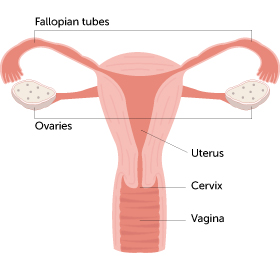Key Facts
- Pelvic exams are done to find out if you have a gynecological problem.
- You may need to have a pelvic exam if you have vaginal discharge, pain, irregular periods, or other symptoms.
- A pelvic exam does not affect your virginity.
- A pelvic exam is needed for a Pap test or an IUD insertion.

You may be worried about your first pelvic exam. It’s very normal to be uneasy about something when you don’t know what to expect. It’s also normal to feel embarrassed. Hopefully after reading this information, you will be reassured that the pelvic exam is simple, usually not painful, and takes only about 3-5 minutes. Your health care provider (HCP) should be sensitive and gentle, help you relax, and answer any questions you have.
What is a pelvic or gynecological exam?
A pelvic exam is a way for your health care provider to examine your female organs and check for any gynecological problems.
When should I have my first pelvic exam?

Most HCPs agree that you should have your first exam when you have symptom such as discharge or pain, or when you turn 21, whichever comes first. There are other important reasons that you may need a pelvic exam. Your HCP will decide if an exam is needed to figure out the cause of your concerns.
Reasons for a pelvic exam may include:
- Unexplained pain in your lower belly or around the vulva area.
- Vaginal discharge or wetness on your underwear that causes itching, burning, or smells bad, especially if you’ve had sex
- No menstrual periods by age 15 or 3 years after your breast development begins
- Vaginal bleeding that lasts more than 10 days
- Missed periods, especially if you are having sex
- Menstrual cramps so bad that you miss school
Remember, it doesn’t matter how old you are or if you are sexually active, if you have any of the symptoms listed above, you should make an appointment with your HCP or gynecologist.
Will I need a pelvic exam if I’m a virgin?
Even if you’re a virgin (you’ve never had vaginal intercourse), you may need a pelvic exam if you are having certain problems. Having a pelvic exam doesn’t change anything, just as using tampons doesn’t change your hymen (the tissue that partly covers the opening to your vagina).
What should I do before the exam?
When you make your appointment, be sure to let the scheduler or nurse know that this is your first pelvic exam. The nurse can answer your questions and help explain what to expect so you won’t be worried.
What kinds of questions will my health care provider (HCP) or gynecologist ask me?
Your HCP will ask you questions about:
- Your general health, allergies and medications you are taking
- Your menstrual period, such as how old you were when you first got it, how long it lasts, how often it comes, how much you bleed, the first day that your last period started, if you have cramps; and at what age your breasts started to develop
- Whether you have ever had sexual contact or have been sexually abused or assaulted
- If you have vaginal itchiness or an unusual discharge (drainage) or odor from your vagina
Getting Ready:
- After you check in for your appointment, it’s a good idea to use the bathroom. Emptying your bladder (peeing) will help to lessen any pressure you may feel during the pelvic exam.
- If you find it helpful, your mom, sister or friend can stay with you. There may also be a nurse or a medical or nursing assistant in the room, too. After you have given your medical history, been weighed and had your blood pressure checked, you will be asked to put on a hospital gown.
- You will need to remove your clothes including your underwear. You may also be asked to remove your bra if a breast exam is indicated.
What happens during the exam?
- Your health care provider will explain the different parts of the exam and ask you to lie down on the exam table. You will be given a sheet to put over your stomach and legs.
- You will then be asked to move down to the end of the table and place your feet in “stirrups” (these are holders for your feet).
- With your knees bent, you will be asked to let your knees fall to each side allowing your legs to spread apart.
This is usually the part when some young people feel embarrassed. Your HCP will make you feel at ease. Don’t be afraid to ask them to walk you through the exam as they go. It’s important to tell your provider if you are scared, nervous, or uncomfortable.
There are usually 3 parts to a pelvic exam. Sometimes not all the parts are necessary. Ask your health care provider which part(s) will be done for your exam.

The External Exam (Part 1): Your health care provider will first look at the area outside of your vagina (clitoris, labia, vaginal opening, and anus).
The Speculum Exam (Part 2):
- The speculum is an instrument made of metal or plastic. A cool water-based lubricant (gel) will be applied. Your HCP will then gently place the speculum into your vagina. The lube will help the speculum glide into your vagina. After the speculum is inserted, it will be gently opened so that your HCP can see your vaginal canal and your cervix (the opening to your uterus). If you like, you can ask your HCP for a mirror so that you can see what your cervix looks like.
- After checking your vagina and cervix, your HCP may than take a sample of mucous (cells) from the cervix using a thin plastic stick and a special tiny brush (that looks like a super tiny broom) and gently wipe away some of the cells from your cervix. This is a Pap test, which can find early changes of the cervix before they become cancer. Most people have normal Pap tests. Normally, a young person will have their first Pap test at age 21. It’s possible that you might need one earlier if you have] HIV or other immune problems.
- If you are having vaginal discharge, your HCP will take another sample to check for yeast and other causes of discharge.
- If you’re having sex, your HCP will take another sample from the cervix and/or vagina and/or a urine test to check for sexually transmitted infections (STIs). When samples have been taken, your HCP will close the speculum and gently take it out of your vagina.
 The Bimanual Exam (Part 3):
The Bimanual Exam (Part 3):
- The last part of the pelvic exam is done to check your female organs (your tubes, ovaries and uterus or womb). Your HCP will insert one or two gloved fingers into your vagina. With the other hand, he or she will gently apply pressure to the lower part of your belly. You may feel slight discomfort or pressure when he or she presses in certain places, but it shouldn’t hurt. If you do feel pain, it’s important to tell your HCP.
- Sometimes your provider will do a rectal exam. This involves inserting one finger into your anus (the opening where bowel movements leave your body). This is usually done at the end of the bimanual exam. Like other parts of the exam, if you relax and take slow deep breaths, it should not be uncomfortable.
When the exam is over
Your HCP will tell you what they found, if your exam is normal, if you need to take any medications, how to get the results of the Pap test and/or other tests, and when to make your next appointment.
Our health guides are developed through a systematic, rigorous process to ensure accuracy, reliability, and trustworthiness. Written and reviewed by experienced healthcare clinicians from Boston Children's Hospital, a Harvard Medical School teaching hospital and consistently ranked as a top hospital by Newsweek and U.S. News & World Report, these guides combine clinical expertise, specialized knowledge, and evidence-based medicine. We also incorporate research and best practices from authoritative sources such as the CDC, NIH, PubMed, top medical journals, and UpToDate.com. Clinical specialists and subject matter experts review and edit each guide, reinforcing our commitment to high-quality, factual, scientifically accurate health information for young people.

